
Oenothera is a genus of about 145 species of herbaceous flowering plants native to the Americas. It is the type genus of the family Onagraceae. Common names include evening primrose, suncups, and sundrops. They are not closely related to the true primroses.

Viola odorata is a species of flowering plant in the genus Viola, native to Europe and Asia. This small hardy herbaceous perennial is commonly known as wood violet, sweet violet, English violet, common violet, florist's violet, or garden violet. It has been introduced into North America and Australia.
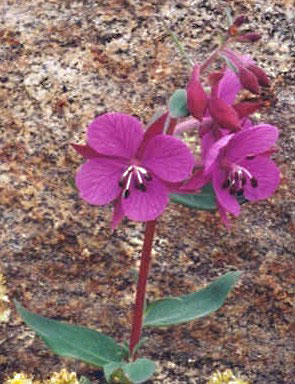
The Onagraceae are a family of flowering plants known as the willowherb family or evening primrose family. They include about 650 species of herbs, shrubs, and trees in 17 genera. The family is widespread, occurring on every continent from boreal to tropical regions.

Myrrhis odorata, with common names cicely, sweet cicely, myrrh, garden myrrh, and sweet chervil, is a herbaceous perennial plant belonging to the celery family Apiaceae. It is the only species in the genus Myrrhis.
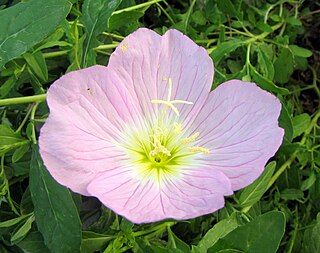
Oenothera speciosa is a species in the evening primrose family known by several common names, including pinkladies, pink evening primrose, showy evening primrose, Mexican primrose, and buttercups.

Oenothera biennis, the common evening-primrose, is a species of flowering plant in the family Onagraceae, native to eastern and central North America, from Newfoundland west to Alberta, southeast to Florida, and southwest to Texas, and widely naturalized elsewhere in temperate and subtropical regions. Evening primrose oil is produced from the plant.

Oenothera lindheimeri, commonly known as Lindheimer's beeblossom, white gaura, pink gaura, Lindheimer's clockweed, and Indian feather, is a species of Oenothera. Several of its common names derive from the genus Gaura, in which this species was formerly placed.
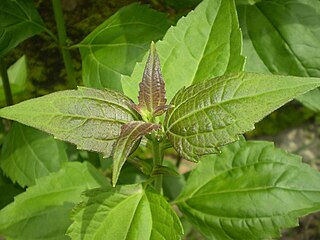
Chromolaena odorata is a tropical and subtropical species of flowering shrub in the family Asteraceae. It is native to the Americas, from Florida and Texas in the United States south through Mexico and the Caribbean to South America. It has been introduced to tropical Asia, West Africa, and parts of Australia.

Oenothera caespitosa, known commonly as tufted evening primrose, desert evening primrose, rock-rose evening primrose, or fragrant evening primrose, is a perennial plant of the genus Oenothera native to much of western and central North America, in habitats such as talus slopes and sandy plains. It is normally night-blooming.
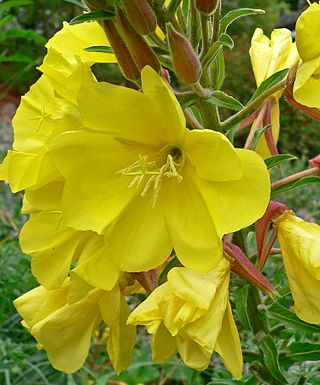
Oenothera elata is a species of Oenothera known by the common name Hooker's evening primrose or tall evening primrose. Subspecies include hookeri, hirsutissima, longisima, jamesii, villosa and elata. It is native to much of western and central North America. The plants are quite tall, especially the hookeri subspecies, native to California, which can reach about 1.8 meters height. The plants are found along roadsides, in moist meadows, or woodland, from sea level up to 9,000 ft (2,700 m) in elevation.

Oenothera deltoides is a species of evening primrose known by several common names, including birdcage evening primrose, basket evening primrose, lion in a cage, and devil's lantern. It is native to the Southwestern United States and northern Mexico, where it grows in sandy habitats from desert to beach.

Oenothera suffrutescens is a species of flowering plant in the evening primrose family known as scarlet beeblossom and scarlet gaura.
Odoratus is a Latin adjective meaning "fragrant, perfumed", and may refer to:
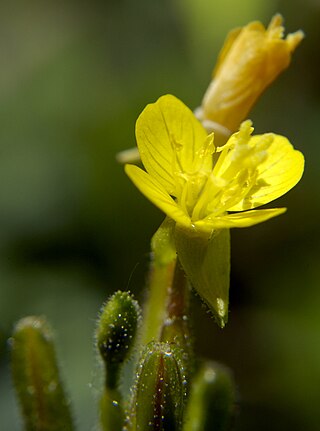
Oenothera perennis is a species of flowering plant in the family Onagraceae and is native to the eastern United States and Canada. Its common names include little evening primrose, small sundrops, and small evening primrose. Its native habitats include shaly slopes, moist or dry fields, pastures and roadsides. Oenothera perennis is a perennial herb. It has yellow flowers that open during the day and close at night. Each flower has four petals that are notched at the tip with veins radiating from the base.
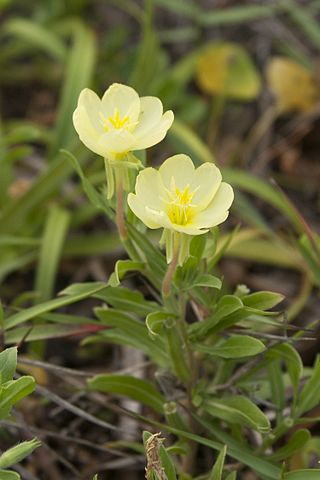
Oenothera laciniata is a species of flowering plant in the evening primrose family known by the common name cutleaf evening primrose. It is native to the eastern United States but it can be found in many other places as an introduced species and sometimes a noxious weed. It is reported from Hawaii, Australia, Britain, France, Korea, Japan, and other areas. This is an annual or short-lived perennial herb producing a spreading stem from a hairy rosette of deeply cut or lobed leaves. Flowers occur in the axils of leaves higher on the stem. Each flower has pale to deep yellow petals up to about 2 centimeters long which fade orange, pink, or red with age. The fruit is a cylindrical capsule up to 5 centimeters in length.

Oenothera macrocarpa, the bigfruit evening primrose, Ozark sundrops, Missouri evening primrose, or Missouri primrose, is a species of flowering plant in the evening primrose family Onagraceae, native to northeast Mexico and the south-central United States, where it is found in calcareous prairies and limestone outcrops.

Agastachys odorata, commonly known as the white waratah or fragrant candlebush, is the sole member of the genus Agastachys in the protea family. It is an evergreen shrub to small tree and is endemic to the heaths and button grass sedgelands of western Tasmania.

Oenothera albicaulis is a New World plant in the evening primrose family. It is known by the common names prairie evening-primrose, white-stem evening-primrose, whitish evening primrose, or whitest evening primrose.
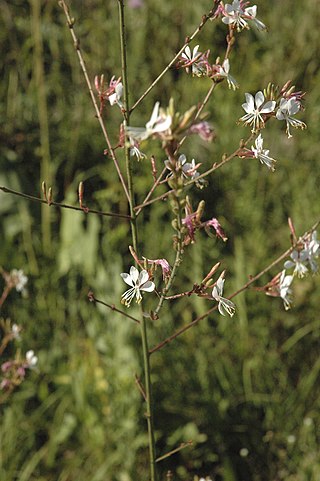
Oenothera gaura, formerly known as Gaura biennis, the biennial gaura or biennial beeblossom, is a North American flowering plant that can reach 6 ft (1.8 m) in height at maturity. Its upper half is made up of flowering stems, which are covered with soft, white hairs. It has light pink colored flowers, which turn a vibrant red/pink color in the late summer to early fall seasons. These colors make this plant attractive to butterflies and bees, and are in full bloom just before many fall plant species begin to bloom.
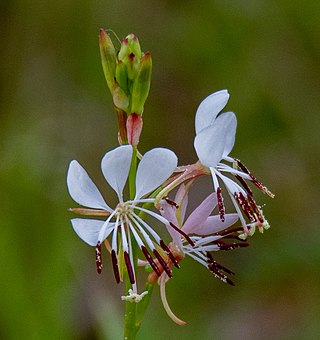
Oenothera suffulta, known as roadside gaura, honeysuckle gaura, or kisses, is a flowering plant in the primrose family, Onagraceae. It is endemic to the United States, in Texas and southern Oklahoma.



















